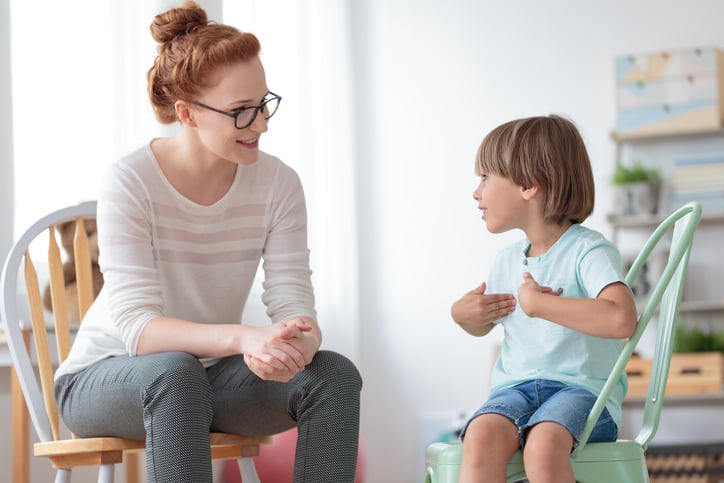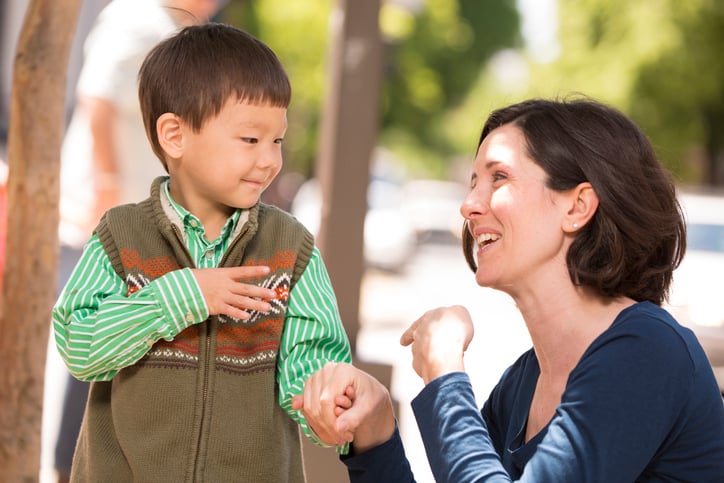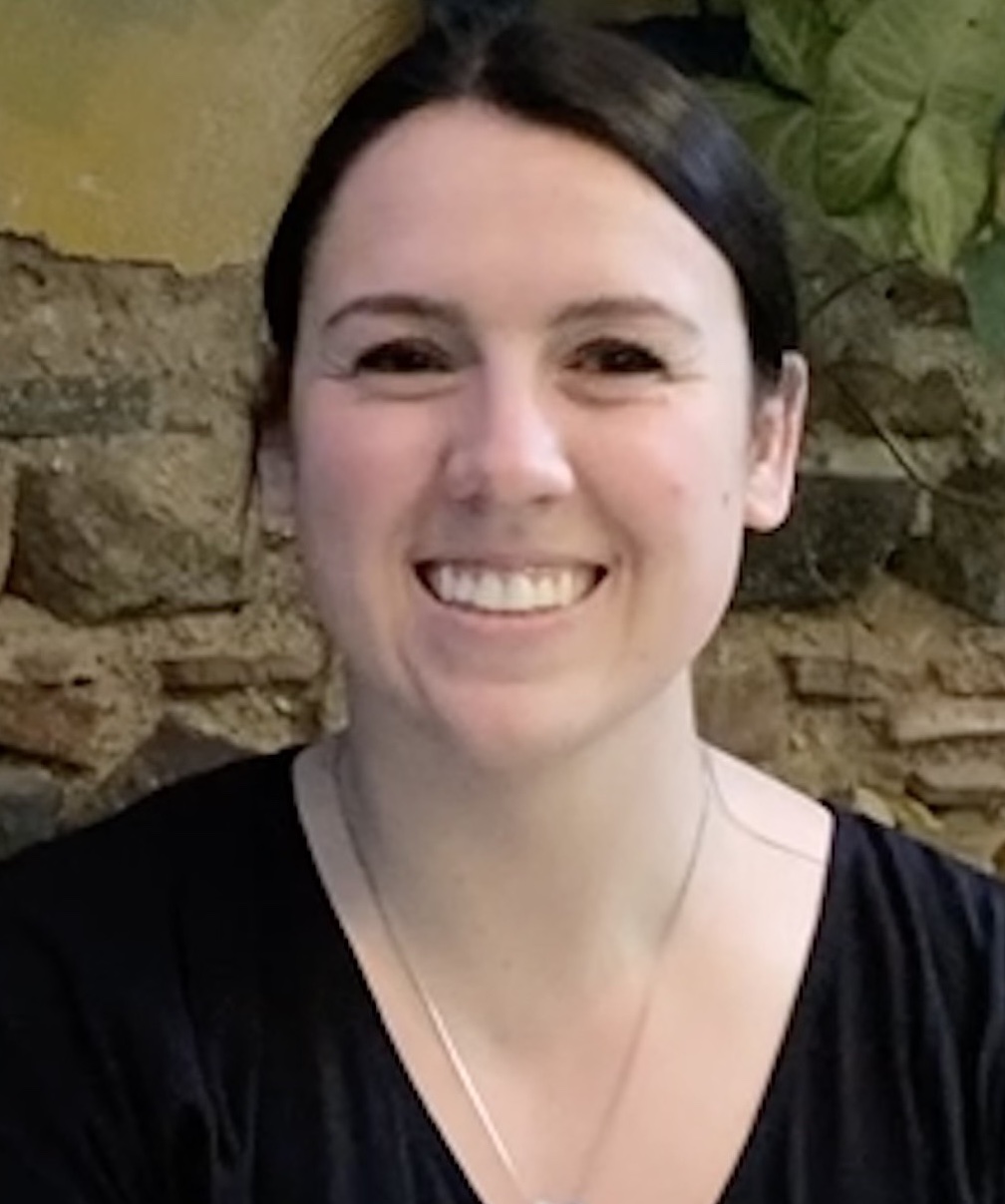Where Do I Start With My Nonverbal Autistic* Child?
First words are a milestone that many parents eagerly await for their young child to achieve. For most children, the first word is spoken around 11-13 months of age. However for some children, especially those children eventually diagnosed or currently diagnosed with autism, a delayed emergence of spoken words is often one of the primary indicators of the diagnosis of autism.
Due to this delayed emergence of spoken language, we often see that our children with autism have a difficult time communicating their wants, needs, and ideas with us. We may also see that our children partake in unwanted behaviors such as aggression, having a tantrum, crying, etc. in order to get their needs met or out of frustration that they are unable to communicate.
What Is Considered Nonverbal?
For some children who are not yet using words to communicate, spoken language will eventually emerge as their primary form of communication. This means they are in the preverbal phase. We all go through a preverbal phase as babies, often understanding words for a period of time before we speak our own. Eventually, these children in the preverbal phase will develop spoken language.
Other children who do not use spoken language may be considered “nonverbal.” An estimated 40% of people diagnosed with autism spectrum disorder are considered nonverbal, meaning that they may never learn to speak or may not speak more than a few words. The underlying cause for an autistic child being nonverbal is unknown. These children often require nonverbal ways to communicate with others. These ways include pointing, sign language, picture exchange, and even more complex communication systems on tablets/iPads. All of these nonverbal forms of communication are considered AAC (alternative and augmented communication). More information can be found at ASHA (The American Speech and Hearing Association: AAC.
Determining if a child is pre-verbal or nonverbal is difficult as they both look the same when observing a child who has not yet used verbal language to communicate. For the sake of this article, I will be providing strategies that will be useful to both pre-verbal children and those children who are eventually considered nonverbal.
Does My Child Need Speech/Language Therapy?
If you are a parent reading this article and have not already, I strongly suggest getting your child evaluated and treated by a speech-language pathologist (also known as a speech therapist or SLP). A common misconception about speech therapists is that they only target speech sound errors such as lisps or trouble with r sounds. However, speech therapists work on language and speech development. They will be able to identify what form of communication -- whether verbal or nonverbal -- will be best for your child to use according to their current skill level. They will also be able to go more into depth with you about the following strategies.
What Are Some Skills and Strategies That Will Increase My Child’s Language?
1. Joint Attention
In order to develop language either verbally or nonverbally a child needs to have the basic skill of maintaining joint attention. Joint attention is a behavior in which two people focus on the same thing. This might be something such as an object/ toy, game, or an event. This behavior often results in the two people interacting with each other. It is a form of early social and communicative behavior. Establishing joint attention on an object will enhance the likelihood of the child attending to and listening to the language being spoken. It will also improve the likelihood that they will be motivated to communicate with others, especially when the environment is manipulated for them to do so (see manipulate the environment below).
At times, children with autism have specific interests. This would be a great time to join your child while partaking in that activity in order to create joint attention. Manipulative toys such as blocks, play food and toy animals are also a great way to create joint attention and provide a surplus of language models to your child.

Ways to obtain joint attention include:
- Use cause-and-effect toys such as the Stages Learning Building Blocks.
- Use toys/objects of interest. Anything your child shows interest in or seems to like.
- Use a sing-songy voice along with exaggerated facial expressions.
- Use simple language.
- Comment on what the child is doing.
- Mimic your child’s actions and play.
- Get on the child’s level (sit/lay on the floor).
2. Manipulate the Environment
Another good strategy is learning how to create desire and manipulate the environment so that the child is required to communicate their wants and needs. Since we are focusing on nonverbal children in this article, communicating their wants and needs does not necessarily mean they must use verbal language to communicate wants and needs. Some ways your child may be able to communicate with you include eye gaze, reaching, pointing, tapping a person for help, vocalizing, pictures, signing, or if able, imitating word productions. Start with a simple form such as eye gaze or what you have seen your child use in the past. Once again, your child’s speech therapist is a great resource when it comes to figuring out how to have your child communicate with you.
An easy thing to do in order to manipulate the environment is to place a desired object out of the child’s reach. In order to receive the item, the child must intentionally communicate that they want the item using one of the forms of communication listed above.
Other ways to create desire or manipulate the environment include:
- Place preferred toys/items in view but out of reach (on a shelf out of reach is a great place to start).
- When your child needs something opened, such as a lid on their food or Play-Doh, wait until they communicate with you that they need help.
- Hold out 2 options, either toys, food, etc., and require your child to communicate with you which option they want.
- Create pictures of frequently used items in the house and have your child point to a desired item to show what they want.
A lot of times as parents, it can seem easy to know what your child wants and to immediately give that to them. You know that the pudding cup needs to be opened for them to eat, or that the Play-Doh jar needs to be opened for them to play. However, requiring your child to request these things is a great learning opportunity for them. Try to think about what you do for your child throughout the day that could actually be a great opportunity for your child to communicate with you. It may seem unnecessary, but it is a great way to help your child grow their communication skills.

3. Model, Model, Model
During the joint attention that you have now established with your child, the next step is to model language for your child. Modeling language is extremely important, as children rely on hearing others’ examples in order to learn how to communicate. Providing a model or example for your child to imitate is critical. For nonverbal children, the primary forms of language modeling are parallel talk, self-talk, and modeling the nonverbal form of communication that they are using.
Parallel talk is when you talk about what you see your child doing: “Oh you’re playing with the truck! You are making it go.” Self-talk is when you talk about what you are doing out loud: “I'm playing with the truck. I like to make the truck go fast.” Basically, one form (parallel talk) is when you talk about what you see your child doing. The other form (self-talk) is when you talk about what you are doing out loud. For both forms, it is best to use simple and grammatically correct utterances.
An important rule of thumb is to ask fewer questions and provide what the answer would have been without ever asking the questions.
Here are some more examples:
- Instead of saying, “What are you doing?”, say, “Oh you’re jumping! You like to jump, jump, jump.”
- Instead of saying, “What’s that?”, say, “It’s a cat (name the object).”
- Instead of saying, “Do you see me eating the apple?”, say, “I’m eating the apple! Apples are yummy. I like to eat apples.”
- When manipulating the environment as mentioned above you can say, “Oh, you want me to open the Play-Doh? Great job letting me know you need help to open.”
I suggest always combining these verbal language models with whatever nonverbal form of language your child might be using. Whether it be eye gaze, reaching, pointing, vocalizing, pictures, or signing.
An example of combining verbal and nonverbal models might be if a desired teddy bear is on a shelf. You can point to the teddy bear and say, “I want the teddy bear.”

4. Wrapping Up
Let’s recap where to start with your nonverbal child.
- First and foremost, if you have concerns with your child’s speech or language skills, please consider having them evaluated by a speech-language pathologist or speech therapist. They will help you determine how your child should best communicate with you.
- Next, work on establishing joint attention through using toys of interest and getting on your child’s level.
- Furthermore, model a lot of language. Talk about what you see your child doing and what you are doing throughout your day.
- Lastly, manipulate the environment and create the desire for your child to communicate with you.
Don’t forget to have fun! You are your child’s ultimate reinforcement to communicate and the best way to learn how. Getting silly and partaking in their favorite activities is the best way for them to establish joint attention and to want to play and learn!
Please tell us what you have done to encourage your child to communicate. We would love to hear from you in our comments section at the end of this post!
We hope you enjoyed the information in this article. STAGES® Learning also offers free downloadable resources to support teaching and learning with individuals with autism. Start with our free Picture Noun Cards and see our collection of other downloadable resources here!
*A Note from Stages Learning: Whenever possible Stages Learning uses the preferences stated by an individual as to whether to use identity-first (“autistic person”) or person-first (“person with autism”) language. In a poll of 21,000 people, 69% preferred identity-first language, and 31% preferred person-first language. A thought piece by Northeastern University indicated that in the majority of cases, autistic people themselves prefer to be called autistic people, whereas caregivers and professionals prefer the wording “people with autism.” We agree with the Northeastern article that the group being talked about should be able to dictate what they are called. As we move forward we plan to alternate our usage in our written materials and in our speech. We recognize the importance of this issue to so many people and we plan to revisit this issue in the coming years with the expectation that preferences will likely continue to shift and we will do our best to reflect these changes. We welcome your thoughts on this issue. Please feel free to contact us.

Ashley McAtee
Ashley McAtee is an Indiana based Speech-Language Pathologist. She lived in Chicago for 3 year where she worked in the preschool setting. She currently works in an ABA center in Indianapolis with autistic children ages 3-10 years. She believes in tailoring her speech services to following the child's needs and interest in order to increase engagement and progress. Her favorite part of her job is creating relationships with the children and watching them grow! Outside of work she loves to travel with her fiance and spend time with her two pups.




